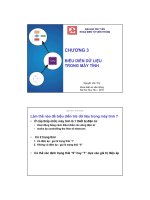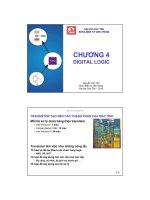Bài giảng Kỹ nghệ máy tính: Chương 3 - Nguyễn Văn Thọ
Bạn đang xem bản rút gọn của tài liệu. Xem và tải ngay bản đầy đủ của tài liệu tại đây (305.09 KB, 17 trang )
CHƯƠNG 3
BIỂU DIỄN DỮ LIỆU
TRONG MÁY TÍNH
Nguyễn Văn Thọ
Khoa Điện tử viễn thông
Đại học Duy Tân – 2010
ĐẠI HỌC DUY TÂN
KHOA ĐIỆN TỬ VIỄN THÔNG
Nguyen Van Tho – Duy Tan University.
Làm thế nào để biểu diễn trữ dữ liệu trong máy tính ?
• Ở cấp thấp nhất, máy tính là 1 thiết bị điện tử
• Hoạt động bằng cách điều khiển các dòng điện tử
• works by controlling the flow of electrons
• Có 2 trạng thái
1. Có điện áp : gọi là trạng thái ‘1”
2. Không có điện áp : gọi là trạng thái “0”
• Có thế xác định trạng thái “0” hay “1” dựa vào giá trị điện áp
Nguyen Van Tho – Duy Tan University.
Máy tính là một hệ thống số.
• Đơn vị cơ sở của thông tin là số nhị phân (bit)
• Tổ hợp nhiều bit sẽ cho nhiều trạng thái hơn
• Tổ hợp của 2 bit cho ta 4 trạng thái :
00, 01, 10, 11
• Tổ hợp của 3 bit cho ta 8 trạng thái:
000, 001, 010, 011, 100, 101, 110, 111
• Tổ hợp của n bits cho ta 2
n
trạng thái.
Binary (base two) system:
• has two states: 0 and 1
Digital system:
• finite number of symbols
Nguyen Van Tho – Duy Tan University.
Các loại dữ liệu cần biểu diễn?
• Numbers – signed, unsigned, integers, floating point,
complex, rational, irrational, …
• Text – characters, strings, …
• Images – pixels, colors, shapes, …
• Sound
• Logical – true, false
• Instructions
• …
• Data type:
• representation and operations within the computer
• We’ll start with numbers…
Nguyen Van Tho – Duy Tan University.
Unsigned Integers (Số nguyên không dấu)
• Trọng số của vị trí
• Vídụ ký hiệu “329”trong hệ thập phân
• “3” có gía trị là 300 trong khi “9” chỉ là 9
329
10
2
10
1
10
0
101
2
2
2
1
2
0
3x100 + 2x10 + 9x1 = 329 1x4 + 0x2 + 1x1 = 5
most
significant
least
significant
Nguyen Van Tho – Duy Tan University.
Unsigned Integers (cont.)
• Một số n-bit kiểu unsigned integer có thể biểu diễn 2
n
giá trị :
từ 0to 2
n
-1.
7111
6011
5101
4001
3110
2010
1100
0000
2
0
2
1
2
2
Nguyen Van Tho – Duy Tan University.
Unsigned Binary Arithmetic
• Base-2 addition – just like base-10!
• add from right to left, propagating carry
10010 10010 1111
+ 1001
+ 1011 +1
11011 11101 10000
10111
+ 111
carry
Subtraction, multiplication, division,…
Nguyen Van Tho – Duy Tan University.
Signed Integers (Số nguyên có dấu)
• Với n bits, ta có 2
n
giá trị .
• Sử dụng 1 nửa cho số dương (1 through 2
n-1
)
và 1 nửa cho số âm (- 2
n-1
through -1)
• that leaves two values: one for 0, and one extra
• Số nguyên dương
• Bit MSB là bit 0
00101 = 5
• Số nguyên âm
• Kiểu dấu-độ lớn : bít dấu =1 để biểu diễn số âm, độ lớn biểu diễn như
số không dấu
10101 = -5
• Số bù 1 – flip every bit to represent negative
11010 = -5
• Trong cả 2 trường hợp , MSB biễu diễn dấu: 0=dương, 1=âm
Nguyen Van Tho – Duy Tan University.
Số bù 2
• Hạn chế của 2 cách biểu diễn trên
• Có 2 cách biểu diễn số 0 (+0 and –0)
• Mạch tính toán phức tạp
¾ Làm thế nào để công 1 số có dấu và 1 số không dấu ?
– Ví dụ : 2 + (-3)
• Biểu diễn bằng số bù 2 giúp phát triển mạch số học dễ dàng hơn.
• Với mỗi số dương (X) , chỉ có 1 giá trị âm (-X) thoã mãn X+ (-X) =0 với
phép cộng bình thường (bỏ qua bit nhớ ngoài)
00101 (5) 01001 (9)
+ 11011 (-5) + (-9)
00000 (0) 00000 (0)
Nguyen Van Tho – Duy Tan University.
Biểu diễn số bù 2
• Nếu là số nguyên dương hoặc số 0
• Biểu diễn số nhị phân bình thường
• Nếu là số âm
• Bắt đầu với số dương tương ứng
• Tính số bù 1 của số dương tương ứng (đảo bit)
• Số bù 2 = Số bù 1 + 1
00101 (5) 01001 (9)
11010 (1’s comp) (1’s comp)
+1 +1
11011 (-5) (-9)
Nguyen Van Tho – Duy Tan University.
Two’s Complement Shortcut
• To take the two’s complement of a number:
• copy bits from right to left until (and including) the first “1”
• flip remaining bits to the left
011010000 011010000
100101111
(1’s comp)
+1
100110000 100110000
(copy)(flip)
Nguyen Van Tho – Duy Tan University.
Two’s Complement Signed Integers
• MSB là bit dấu–nócótrọng số là –2
n-1
.
• Phạm vi biểu diễn của số n-bit là : -2
n-1
tới 2
n-1
–1.
• The most negative number (-2
n-1
) has no positive counterpart.
0
0
0
0
0
0
0
0
-2
3
7111
6011
5101
4001
3110
2010
1100
0000
2
0
2
1
2
2
1
1
1
1
1
1
1
1
-2
3
-1111
-2011
-3101
-4001
-5110
-6010
-7100
-8000
2
0
2
1
2
2
Nguyen Van Tho – Duy Tan University.
Chuyển đổi từ hệ 2 (Binary) sang hệ 10 (Decimal)
1. If leading bit is one, take two’s complement to
get a positive number.
2. Add powers of 2 that have “1” in the
corresponding bit positions.
3. If original number was negative,
add a minus sign.
102410
5129
2568
1287
646
325
164
83
42
21
10
2
n
n
X = 01101000
two
=2
6
+2
5
+2
3
= 64+32+8
= 104
ten
Assuming 8-bit 2’s complement numbers.
Nguyen Van Tho – Duy Tan University.
More Examples
102410
5129
2568
1287
646
325
164
83
42
21
10
2
n
n
Assuming 8-bit 2’s complement numbers.
X = 00100111
two
=2
5
+2
2
+2
1
+2
0
= 32+4+2+1
=39
ten
X = 11100110
two
-X = 00011010
=2
4
+2
3
+2
1
= 16+8+2
=26
ten
X = -26
ten
Nguyen Van Tho – Duy Tan University.
Chuyển đổi từ hệ 10 sang hệ 2
• First Method: Division
1. Find magnitude of decimal number. (Always positive.)
2. Divide by two – remainder is least significant bit.
3. Keep dividing by two until answer is zero,
writing remainders from right to left.
4. Append a zero as the MS bit;
if original number was negative, take two’s complement.
X = 104
ten
104/2 = 52 r0 bit 0
52/2 = 26 r0 bit 1
26/2 = 13 r0 bit 2
13/2 = 6 r1 bit 3
6/2 = 3 r0 bit 4
3/2 = 1 r1 bit 5
X = 01101000
two
1/2 = 0 r1 bit 6
Nguyen Van Tho – Duy Tan University.
Chuyển đổi từ hệ 10 sang hệ 2
• Second Method: Subtract Powers of Two
1. Find magnitude of decimal number.
2. Subtract largest power of two
less than or equal to number.
3. Put a one in the corresponding bit position.
4. Keep subtracting until result is zero.
5. Append a zero as MS bit;
if original was negative, take two’s complement.
X = 104
ten
104 - 64 = 40 bit 6
40 - 32 = 8 bit 5
8 - 8 = 0 bit 3
X = 01101000
two
102410
5129
2568
1287
646
325
164
83
42
21
10
2
n
n
Nguyen Van Tho – Duy Tan University.
Phép toán: Số học và Logic
• Recall:
a data type includes representation and operations.
• We now have a good representation for signed integers,
so let’s look at some arithmetic operations:
• Addition
• Subtraction
• Sign Extension
• We’ll also look at overflow conditions for addition.
• Multiplication, division, etc., can be built from these
basic operations.
• Logical operations are also useful:
• AND
• OR
• NOT
Nguyen Van Tho – Duy Tan University.
Phép cộng
• As we’ve discussed, 2’s comp. addition is just
binary addition.
• assume all integers have the same number of bits
• ignore carry out
• for now, assume that sum fits in n-bit 2’s comp. representation
01101000 (104) 11110110 (-10)
+ 11110000 (-16) + (-9)
01011000 (98) (-19)
Assuming 8-bit 2’s complement numbers.
Nguyen Van Tho – Duy Tan University.
Phép trừ
• Negate subtrahend (2nd no.) and add.
• assume all integers have the same number of bits
• ignore carry out
• for now, assume that difference fits in n-bit 2’s comp.
representation
01101000 (104) 11110110 (-10)
- 00010000 (16) - (-9)
01101000 (104) 11110110 (-10)
+ 11110000 (-16) + (9)
01011000 (88) (-1)
Assuming 8-bit 2’s complement numbers.
Nguyen Van Tho – Duy Tan University.
Chú ý với số có dấu
• Để cộng 2 số, ta phải biểu diễn số đó dưới dạng các số nhị
phân có số bit như nhau.
• Thêm 0 vào bên trái để đủ số bit
• Instead, replicate the MS bit the sign bit:
4-bit 8-bit
0100 (4) 00000100 (still 4)
1100 (-4) 00001100 (12, not -4)
4-bit 8-bit
0100 (4) 00000100 (still 4)
1100 (-4) 11111100 (still -4)
Nguyen Van Tho – Duy Tan University.
Tràn số
• Nếu 2 toán hạng quá lớn, kết quả phép toán không chính
xác.
• Tràn số xảy ra nếu
• Dấu của 2 toán hạng giống nhau và
• Dấu của kết quả khác dấu 2 toán hạng.
01000 (8) 11000 (-8)
+ 01001 (9) +10111 (-9)
10001 (-15) 01111 (+15)
Nguyen Van Tho – Duy Tan University.
Logical Operations
• Operations on logical TRUE or FALSE
• two states takes one bit to represent: TRUE=1, FALSE=0
• View n-bit number as a collection of n logical values
• operation applied to each bit independently
1
1
0
0
A
11
00
01
00
A AND BB
1
1
0
0
A
11
10
11
00
A OR BB
1
0
A
0
1
NOT A
Nguyen Van Tho – Duy Tan University.
Examples of Logical Operations
• AND
• useful for clearing bits
¾AND with zero = 0
¾AND with one = no change
• OR
• useful for setting bits
¾OR with zero = no change
¾OR with one = 1
• NOT
• unary operation one argument
• flips every bit
11000101
AND 00001111
00000101
11000101
OR 00001111
11001111
NOT 11000101
00111010
Nguyen Van Tho – Duy Tan University.
Hexadecimal Notation
• It is often convenient to write binary (base-2) numbers
as hexadecimal (base-16) numbers instead.
• fewer digits four bits per hex digit
• less error prone easy to corrupt long string of 1’s and 0’s
7
6
5
4
3
2
1
0
Hex
70111
60110
50101
40100
30011
20010
10001
00000
DecimalBinary
F
E
D
C
B
A
9
8
Hex
151111
141110
131101
121100
111011
101010
91001
81000
DecimalBinary
Nguyen Van Tho – Duy Tan University.
Converting from Binary to Hexadecimal
• Every four bits is a hex digit.
• start grouping from right-hand side
011101010001111010011010111
7D4F8A3
This is not a new machine representation,
just a convenient way to write the number.
Nguyen Van Tho – Duy Tan University.
Số thập phân : Dấu chấm tĩnh (Fixed-Point)
• Làm thế nào để biễu diễn số thập phân?
• Use a “binary point” to separate positive
from negative powers of two just like “decimal point.”
• 2’s comp addition and subtraction still work.
¾if binary points are aligned
00101000.101 (40.625)
+ 11111110.110 (-1.25)
00100111.011 (39.375)
2
-1
= 0.5
2
-2
= 0.25
2
-3
= 0.125
No new operations same as integer arithmetic.
Nguyen Van Tho – Duy Tan University.
Số rất lớn và số rất nhỏ : Dấu chấm động (Floating-Point)
• Giá trị lớn : 6.023 x 10
23
cần 79 bits
• Giá trị nhỏ : 6.626 x 10
-34
cần >110 bits
• Đưa về dạng biểu diễn : F x 2
E
• IEEE 754 Floating-Point
¾ Độ chính xác đơn : Single-precision (32-bits)
¾ Độ chính xác kép : Double-precision (64-bits)
Nguyen Van Tho – Duy Tan University.
Dấu chấm động
• IEEE-754 format cho độ chính xác đơn (single-precision)
1 sign bit: 0 dương, 1 âm
8 bit biased exponent= exponent + 127
24 bit mantissa chuẩn hoá = 1 bit ẩn + 23 bit fraction
Chuẩn hoá định trị :cógiátrị giữa 1 và 2 : 1.f
022233031
S
biased exponent e
fraction f of normalized mantissa
0exponent,2fraction.0)1(
254exponent1,2fraction.1)1(
126
127exponent
=××−=
≤≤××−=
−
−
S
S
N
N
Nguyen Van Tho – Duy Tan University.
Floating Point Example
• Single-precision IEEE floating point number:
• 10111111010000000000000000000000
• Sign is 1 – number is negative.
• Exponent field is 01111110 = 126 (decimal).
• Fraction is 0.100000000000… = 0.5 (decimal).
• Value = -1.5 x 2
(126-127)
= -1.5 x 2
-1
= -0.75.
sign exponent fraction
Ví dụ: biểu diễn 0.1011 dưới dạng IEEE-754
Sign bit s=0
chuẩn hoá : 0.1011=1.011*2-1
exponent: -1 + 127=126=01111110
IEEE format: 0 01111110 0110000000000000000000
Nguyen Van Tho – Duy Tan University.
Dấu chấm động
• IEEE-754 format cho độ chính xác kép (double-precision)
051526263
S
biased exponent e
fraction f of normalized mantissa
1 sign bit: 0 dương, 1 âm
11 bit biased exponent= exponent + 1023
53 bit mantissa chuẩn hoá = 1 bit ẩn + 52 bit fraction
double precision: (-1)
s
x 2
e-1023
x (1.f)
2
single precision: (-1)
s
x 2
e-127
x (1.f)
2
Nguyen Van Tho – Duy Tan University.
Text: ASCII Characters
• ASCII: Maps 128 characters to 7-bit code.
• both printable and non-printable (ESC, DEL, …) characters
del7fo6f_5fO4f?3f/2fus1fsi0f
~7en6e^5eN4e>3e.2ers1eso0e
}7dm6d]5dM4d=3d-2dgs1dcr0d
|7cl6c\5cL4c<3c,2cfs1cnp0c
{7bk6b[5bK4b;3b+2besc1bvt0b
z7aj6aZ5aJ4a:3a*2asub1anl0a
y79i69Y
59I49939)29em19ht09
x78h68X58H48838(28can18bs08
w77g67W57G47737'27etb17bel07
v76f66V56F46636&26syn16ack06
u75e65U55E45535%25nak15enq05
t74d64T54D44434$24dc414eot04
s73c63S53C43333
#23dc313etx03
r72b62R52B42232"22dc212stx02
q71a61Q51A41131!21dc111soh01
p70`60P50@40030sp20dle10nul00
Nguyen Van Tho – Duy Tan University.
Interesting Properties of ASCII Code
• What is relationship between a decimal digit ('0', '1', …)
and its ASCII code?
• What is the difference between an upper-case letter
('A', 'B', …) and its lower-case equivalent ('a', 'b', …)?
• Given two ASCII characters, how do we tell which comes
first in alphabetical order?
• Are 128 characters enough?
( />No new operations integer arithmetic and logic.
Nguyen Van Tho – Duy Tan University.
Other Data Types
• Text strings
• sequence of characters, terminated with NULL (0)
• typically, no hardware support
• Image
• array of pixels
¾monochrome: one bit (1/0 = black/white)
¾color: red, green, blue (RGB) components (e.g., 8 bits each)
¾other properties: transparency
• hardware support:
¾typically none, in general-purpose processors
¾MMX multiple 8-bit operations on 32-bit word
• Sound
• sequence of fixed-point numbers
Nguyen Van Tho – Duy Tan University.









